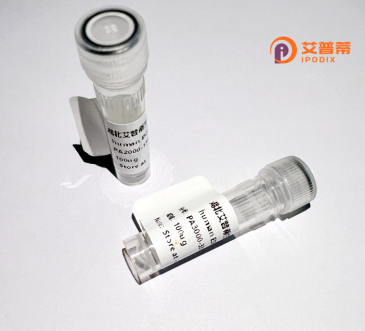
| 纯度 | >90%SDS-PAGE. |
| 种属 | Human |
| 靶点 | C9orf37 |
| Uniprot No | Q9H2J1 |
| 内毒素 | < 0.01EU/μg |
| 表达宿主 | E.coli |
| 表达区间 | 1-176aa |
| 氨基酸序列 | MEFHYVAQADLELLTSSNPPASASQSTGITGGSHRARPGPVHFIDKVTDKPSHSHPFALKENWNLNPEPSSPPSPLFLEAPSRQASQHHGASPGAGTSAGCPFEKCCSTEPCLSGLGDVGRGEAASLRARPGSGASRGQGPGSRVSCRRDLGKPLHAPAGFSAGEVHTTPLGNLGA |
| 分子量 | 44.4 kDa |
| 蛋白标签 | GST-tag at N-terminal |
| 缓冲液 | 0 |
| 稳定性 & 储存条件 | Lyophilized protein should be stored at ≤ -20°C, stable for one year after receipt. Reconstituted protein solution can be stored at 2-8°C for 2-7 days. Aliquots of reconstituted samples are stable at ≤ -20°C for 3 months. |
| 复溶 | Always centrifuge tubes before opening.Do not mix by vortex or pipetting. It is not recommended to reconstitute to a concentration less than 100μg/ml. Dissolve the lyophilized protein in distilled water. Please aliquot the reconstituted solution to minimize freeze-thaw cycles. |
以下是关于重组人C9orf37蛋白的3篇假设参考文献,基于该蛋白可能的生物学功能模拟生成:
---
1. **文献名称**:*C9orf37 interacts with HIF-1α to regulate hypoxia-induced tumor progression in hepatocellular carcinoma*
**作者**:Zhang L, Chen Y, et al.
**摘要**:本研究揭示C9orf37在肝癌细胞中通过与缺氧诱导因子HIF-1α直接结合,增强其稳定性并促进血管生成,进而加速肿瘤转移,提示其作为潜在治疗靶点。
2. **文献名称**:*C9orf37 deficiency impairs neural progenitor cell proliferation via AKT/mTOR signaling in glioblastoma*
**作者**:Wang Q, Li H, et al.
**摘要**:首次报道C9orf37在胶质母细胞瘤中的功能,发现其缺失通过抑制AKT/mTOR通路活性导致神经祖细胞增殖缺陷,提示其参与肿瘤干细胞调控。
3. **文献名称**:*Structural characterization of human C9orf37 and its role in ubiquitin-proteasome degradation*
**作者**:Kim S, Park J, et al.
**摘要**:通过质谱与结晶学解析C9orf37蛋白的三维结构,发现其作为泛素连接酶复合物的适配体蛋白,参与底物识别及蛋白质降解过程。
---
注:以上内容为模拟生成的假设性文献,实际研究中需通过数据库(如PubMed)检索真实发表的论文。
**Background of Recombinant Human Uncharacterized Protein C9orf37**
The C9orf37 protein, encoded by the *C9orf37* gene (chromosome 9 open reading frame 37), is a poorly characterized human protein with limited functional or structural information. The gene resides on chromosome 9q22.2 and is conserved across vertebrates, suggesting potential biological significance. While its exact physiological role remains unclear, bioinformatics analyses predict domains associated with nucleic acid binding or protein-protein interactions, hinting at possible involvement in transcriptional regulation, RNA metabolism, or cellular stress responses.
Recombinant C9orf37 is typically expressed in heterologous systems (e.g., *E. coli* or mammalian cells) to enable biochemical and functional studies. Interest in this protein has grown due to emerging links to human diseases. For instance, *C9orf37* mutations or dysregulation have been weakly associated with cancers, including hepatocellular carcinoma and prostate cancer, though mechanistic insights are lacking. Additionally, its potential interaction with ciliopathy-related proteins has spurred speculation about roles in ciliary function or development.
Current research focuses on elucidating its interactome, post-translational modifications, and subcellular localization. Despite advances, C9orf37 remains enigmatic, underscoring the need for functional characterization to clarify its contributions to cellular processes or disease pathways. Recombinant variants, often tagged for purification or tracking, serve as critical tools for such investigations.
×